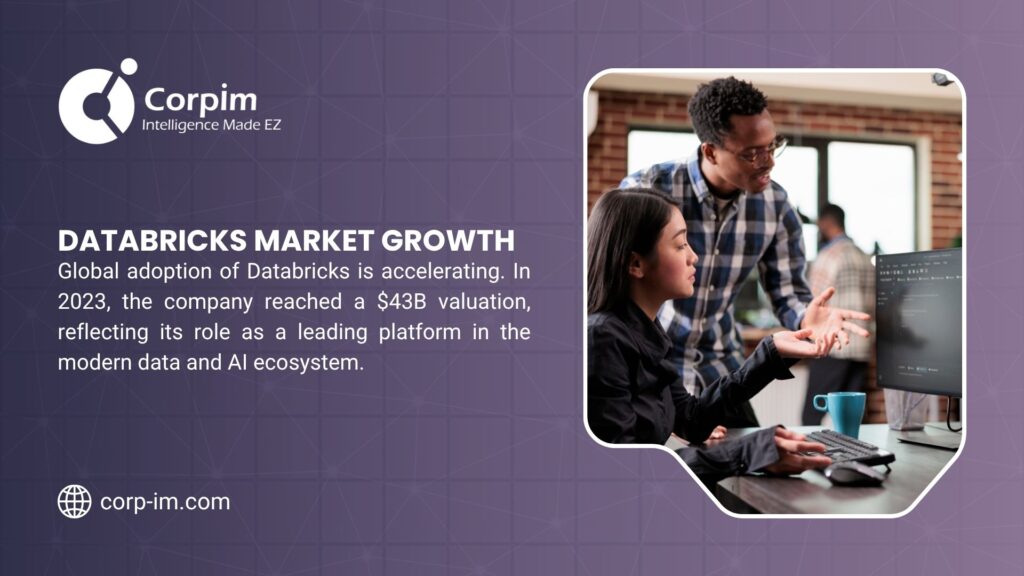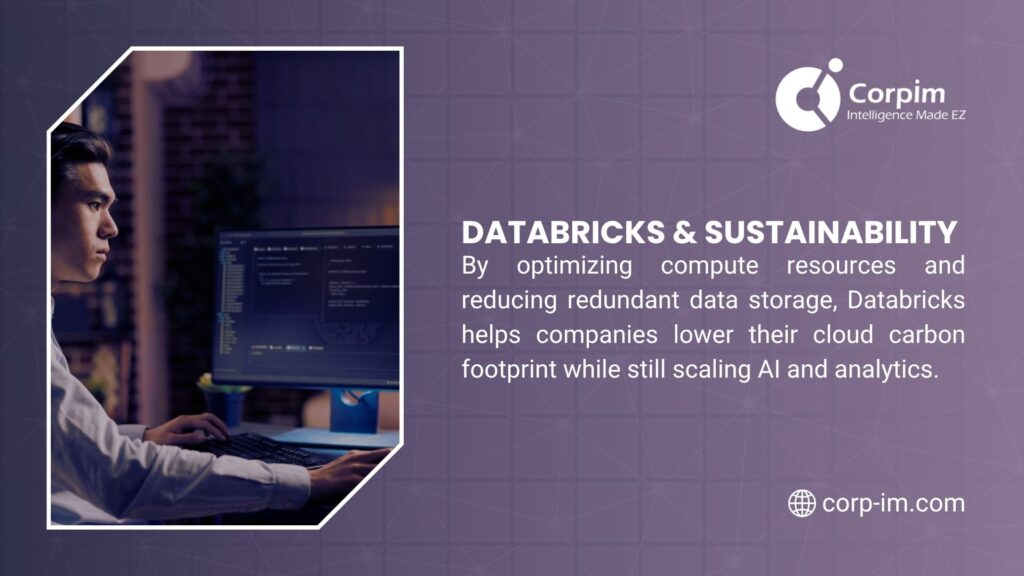Have you been looking for a better way to organize your data and came across Databricks, but still wondering what it actually is and how it can help you?
This article is meant to educate you on what Databricks is, what it is used for and how it makes handling data simpler and more effective.
What Is Databricks?
Databricks is a platform that brings data engineering, data science, and business analytics together in one place. It was built by the same team that created Apache Spark and the goal was to make big data easier and more effective to manage.
This platform gives teams a single workspace where they can work on data projects together and makes it possible to process huge amounts of data without having to deal with complicated.
The platform runs on the cloud with providers like AWS, Azure, and Google Cloud. This means that your company doesn’t need any expensive hardware to use it, and it can easily scale resources as their needs grow.
What Is Databricks Used For?
Many companies use Databricks for data problems that traditional tools struggle with. The platform is great at handling large amounts of data and also good for making advanced analytics easy for business teams.
The three categories that need Databricks more are:
- Data engineering teams
- Data scientists
- Business analysts
Data engineering teams use Databricks to build and manage data pipelines. These pipelines move data from different sources into usable formats, processing millions of records every day, keeping the data clean and also making the data pipeline architecture more efficient.
Data scientists rely on the platform for machine learning projects that need a lot of computing power. Databricks comes with ready-to-use environments, with popular libraries and tools already set up.
Business analysts can access organized and cleaned data through simple SQL interfaces, without needing to know complicated programming. They create reports and dashboards that help executives make smart decisions based on up-to-date data.
Learning more for data analytics helps with explaining why Databricks has become so important for modern data operations in many industries.
What Problem Does Databricks Solve?
Traditional data infrastructure creates big problems that waste time and money. Databricks solves these problems directly with solutions that actually work in real-world business situations.
Below is the table that compares Databricks’ solutions with other traditional approaches.
Traditional Approach | Databricks Solution | Business Impact |
Multiple disconnected tools | Single unified platform | 40% faster project completion |
Manual infrastructure management | Automated resource handling | 60% reduction in DevOps costs |
Separate data copies | Shared data lakehouse | 50% lower storage costs |
Limited collaboration | Real-time team workspace | 3x improvement in productivity |

6 Common Use Cases Of Databricks
Companies in different industries use Databricks to solve real business problems that need fast processing of large amounts of data. These Databricks use cases show how the platform brings value in practical ways
- Customer Analytics and Personalization
Many businesses that are in the e-commerce market analyze the behaviour patterns of customers to create personalized shopping experiences. Databricks processes millions of transactions every day to find trends and predict what customers want next.
Banks use Databricks to analyze spending patterns and offer tailored financial products. This real-time analysis helps them compete with fintech startups that rely on data-driven customer experiences, especially when combined with business intelligence strategies.
- Fraud Detection and Risk Management
Financial institutions process billions of transactions through machine learning models that spot suspicious patterns. What is Databricks bringing to fraud prevention? Speed that matters when stopping fraudulent transactions before they complete.
Insurance companies analyze claims data to identify patterns that indicate fraud. The platform processes historical claims alongside current submissions to flag suspicious activities automatically.
- Keep Machines Running Smoothly
Manufacturing companies monitor equipment sensors to predict failures before they happen. Databricks processes sensor data from thousands of machines simultaneously, alerting teams when maintenance becomes necessary.
This saves companies a lot of money by avoiding unexpected breakdowns. They can plan maintenance at the right time instead of stopping production for emergency fixes.
- Efficient Shipping and Stock Management
Logistics companies keep track of millions of shipments and find the best delivery routes in real time. Databricks looks at traffic, weather, and schedules to make routes more efficient.
Retailers use it to predict demand and manage inventory across many locations. This prevents running out of stock or having too much inventory that wastes money.
- Healthcare and Life Sciences
Hospitals use patient data to improve treatments and lower costs. Databricks helps them follow strict privacy rules while getting useful insights from medical records.
Pharmaceutical companies use the platform to speed up drug discovery. It analyzes large datasets from clinical trials and genetic data to find promising drug candidates faster.
- Media and Entertainment
Streaming services study what people watch to suggest content that keeps them engaged. Databricks handles billions of viewing events to see what works for different types of audiences.
Gaming companies use it to adjust game difficulty and rewards based on player behavior. This makes games more fun and keeps players coming back, which also helps increase revenue.
Databricks use cases help your business to find opportunities where the platform could solve their specific data challenges.
The 7 Benefits That Databricks Offers To You
The Databricks platform delivers advantages that go beyond just processing data faster. These 7 Databricks benefits impact how teams work, how much companies spend, and what they can achieve with their data.
- Unified Data Management
All data stays in one place instead of being scattered across different systems. Teams can access the same data without making copies or worrying about version conflicts.
This approach can cut storage costs by 30–50%, since companies don’t need extra copies of data. Data quality improves too, because there’s one clear source of truth.
- Simplified Collaboration
Data engineers, scientists, and analysts work together in shared notebooks where everyone sees the same information. Teams can comment on each other’s work and build on previous analyses without starting over.
Projects finish about 40% quicker when teams collaborate this way. Knowledge stays in the organization instead of getting stuck in individual tools or files.
- Smart and Affordable Scaling
Companies pay only for the computing power they actually use. Databricks automatically scales up during busy times and scales down when demand drops, so there’s no wasted infrastructure.
Cost Factor | Traditional Infrastructure | Databricks Approach | Typical Savings |
Hardware Investment | $500K-$2M upfront | $0 upfront | 100% capital savings |
Idle Resource Costs | 40-60% waste | 5-10% waste | 50% reduction |
Maintenance Staff | 3-5 FTEs | 0-1 FTE | 70% labor savings |
Software Licenses | Multiple vendor costs | Single platform | 40% consolidation savings |
- Faster Time to Insights
Analysts get answers in hours instead of waiting days or weeks for data preparation. But what is Databricks doing differently is that it automates data preparation tasks that used to require manual coding and troubleshooting.
Machine learning models that used to take months to build and launch can now go live in just a few weeks. This speed helps companies react to market changes faster than their competitors.
- Strong Security
The platform provides built-in security controls that meet strict compliance requirements for industries like finance and healthcare. Data stays encrypted whether stored or moving between systems.
Companies manage who can access what data through centralized controls instead of configuring permissions across multiple systems. Audit logs track every action for compliance reporting.
- AI and Machine Learning Acceleration
Data scientists access pre-built machine learning frameworks and libraries without complex setup. The platform handles distributed computing automatically, so models train on massive datasets without custom coding.
Databricks’ generative AI capabilities help teams build and deploy large language models for specific business applications. This makes advanced AI accessible to companies without specialized research teams.
- Multi-Cloud Flexibility
Businesses can run Databricks on AWS, Azure, or Google Cloud without changing their code. This flexibility avoids being stuck with one provider and helps them get better cloud pricing
The companies that get the most out of Databricks treat it as more than just a new tool. They change the way teams work together, make data easy for everyone to access, and often back it up with smart business intelligence strategies.

Integration with Modern Data Stack
The Databricks platform connects seamlessly with other tools that companies already use, making it practical to adopt without replacing entire technology stacks. This integration capability accelerates implementation and reduces risk.
Cloud Storage Services like AWS S3, Azure Data Lake, and Google Cloud Storage work directly with Databricks. Data stays in existing storage locations while the platform processes it without creating expensive copies.
Business Intelligence Tools such as Tableau, Power BI, and Looker connect directly to Databricks for real-time reporting. Business users access current data through familiar interfaces without learning new tools, which enhances business intelligence reporting capabilities.
Data Integration Platforms like Fivetran, Airbyte, and Apache Kafka feed data into Databricks from hundreds of source systems. These connectors eliminate custom coding for common data sources.
MLOps Tools help teams deploy and monitor machine learning models in production. The platform integrates with tools like MLflow for model tracking and management throughout the lifecycle.
Cloud computing principles apply to data platforms to help with explaining why integration matters so much for successful implementations.
Databricks vs Traditional Data Warehouses
| Feature / Aspect | Traditional Data Warehouse | Databricks Lakehouse |
| Data Type | Mostly structured data | Structured and unstructured data |
| Queries | Predefined queries | Fast SQL and flexible exploratory analytics |
| Schema Design | Requires extensive upfront planning | Flexible, adapts to changing data |
| Performance | Can struggle with large or changing data | High performance for both structured and unstructured data |
| Cost Model | Based on data volume and query complexity | Based on actual compute time used |
| Data Access | Limited to structured data | Unified access to all data types |
| Flexibility | Low | High – combines warehouse speed with lake flexibility |
| Business Use | Good for predictable workloads | Suitable for analytics, ML, AI, and real-time insights |
Traditional data warehouses base their charges on data size and query complexity, which can make costs unpredictable as your data grows. So, what is Databricks doing differently? The platform charges for actual compute time used, making costs more predictable and controllable.

Frequently Asked Questions (FAQ) About Databricks
- What is Databricks?
Databricks is a platform that combines data engineering, data science and business analytics all in one. Databricks was created by the same team that built Apache Spark with a mission to simplify and streamline managing big data.
- What makes Databricks different from other data platforms?
Databricks differs from other data platforms through its lakehouse architecture, which combines the flexibility of data lakes with the performance of data warehouses in a single platform.
- Do we need to move all our data to use Databricks?
No, Databricks works with data where it already lives in cloud storage. The platform processes data in place without requiring copies or migrations.
- How long does it take to implement Databricks?
A typical Databricks setup can start showing results in 4–8 weeks, but the total time depends on how big and complex the project is.
- Is Databricks suitable for small businesses?
Yes. If your business is small sized, Databricks can be suitable for you, especially if you work with lots of data or want to grow analytics and AI capabilities.













